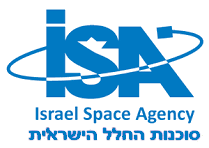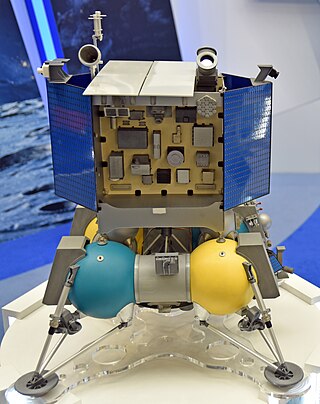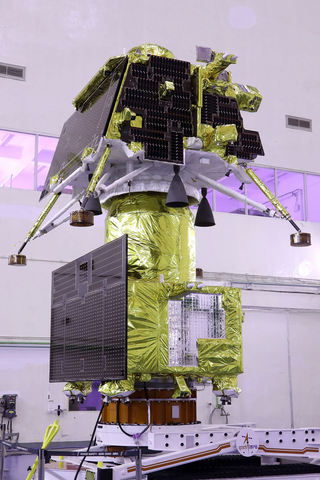Related Research Articles

A retroreflector is a device or surface that reflects radiation back to its source with minimum scattering. This works at a wide range of angle of incidence, unlike a planar mirror, which does this only if the mirror is exactly perpendicular to the wave front, having a zero angle of incidence. Being directed, the retroflector's reflection is brighter than that of a diffuse reflector. Corner reflectors and cat's eye reflectors are the most used kinds.

Lunar Laser Ranging (LLR) is the practice of measuring the distance between the surfaces of the Earth and the Moon using laser ranging. The distance can be calculated from the round-trip time of laser light pulses travelling at the speed of light, which are reflected back to Earth by the Moon's surface or by one of several retroreflectors installed on the Moon. Three were placed by the United States' Apollo program, two by the Soviet Lunokhod 1 and 2 missions, and one by India's Chandrayaan-3 mission.

The NASA Deep Space Network (DSN) is a worldwide network of spacecraft communication ground segment facilities, located in the United States (California), Spain (Madrid), and Australia (Canberra), that supports NASA's interplanetary spacecraft missions. It also performs radio and radar astronomy observations for the exploration of the Solar System and the universe, and supports selected Earth-orbiting missions. DSN is part of the NASA Jet Propulsion Laboratory (JPL).

The Goddard Space Flight Center (GSFC) is a major NASA space research laboratory located approximately 6.5 miles (10.5 km) northeast of Washington, D.C., in Greenbelt, Maryland, United States. Established on May 1, 1959 as NASA's first space flight center, GSFC employs about 10,000 civil servants and contractors. Named for American rocket propulsion pioneer Robert H. Goddard, it is one of ten major NASA field centers. GSFC is partially within the former Goddard census-designated place; it has a Greenbelt mailing address.

The Japan Aerospace Exploration Agency (JAXA) is the Japanese national air and space agency. Through the merger of three previously independent organizations, JAXA was formed on 1 October 2003. JAXA is responsible for research, technology development and launch of satellites into orbit, and is involved in many more advanced missions such as asteroid exploration and possible human exploration of the Moon. Its motto is One JAXA and its corporate slogan is Explore to Realize.
The Lunar Precursor Robotic Program (LPRP) is a NASA program that uses robotic spacecraft to prepare for future crewed missions to the Moon. The program gathers data such as lunar radiation, surface imaging, areas of scientific interest, temperature and lighting conditions, and potential resource identification.

The Israel Space Agency is a governmental body, a part of Israel's Ministry of Science and Technology, that coordinates all Israeli space research programs with scientific and commercial goals.

A moonbase is a human outpost on or below the surface of the Moon. More than a mere site of activity or temporary camp, moonbases are extraterrestrial bases, supporting robotic or human activity, by providing surface infrastructure. Missions to the Moon have realized single-mission bases,, as well as some small permanent installations.

Third-party evidence for Apollo Moon landings is evidence, or analysis of evidence, about the Moon landings that does not come from either NASA or the U.S. government, or the Apollo Moon landing hoax theorists. This evidence provides independent confirmation of NASA's account of the six Apollo program Moon missions flown between 1969 and 1972.

The Lunar Reconnaissance Orbiter (LRO) is a NASA robotic spacecraft currently orbiting the Moon in an eccentric polar mapping orbit. Data collected by LRO have been described as essential for planning NASA's future human and robotic missions to the Moon. Its detailed mapping program is identifying safe landing sites, locating potential resources on the Moon, characterizing the radiation environment, and demonstrating new technologies.

The National Aeronautics and Space Administration is an independent agency of the U.S. federal government responsible for the civil space program, aeronautics research, and space research. Established in 1958, it succeeded the National Advisory Committee for Aeronautics (NACA) to give the U.S. space development effort a distinct civilian orientation, emphasizing peaceful applications in space science. It has since led most of America's space exploration programs, including Project Mercury, Project Gemini, the 1968–1972 Apollo Moon landing missions, the Skylab space station, and the Space Shuttle. Currently, NASA supports the International Space Station (ISS) along with the Commercial Crew Program, and oversees the development of the Orion spacecraft and the Space Launch System for the lunar Artemis program.

Phobos And Deimos & Mars Environment (PADME) is a low-cost NASA Mars orbiter mission concept that would address longstanding unknowns about Mars' two moons Phobos and Deimos and their environment.

Luna 27 is a planned lunar lander mission by the Roscosmos with collaboration by the European Space Agency (ESA) to send a lander to the South Pole–Aitken basin, an area on the far side of the Moon. Its objective will be to detect and characterise lunar polar volatiles. The mission is a continuation of the Luna-Glob programme.

Meteor-3M No.1 was the first and only of the Meteor-3M series polar-orbiting weather satellites. It was launched on 10 December 2001 at 17:18:57 UTC from the Baikonur Cosmodrome in Kazakhstan. The satellite is in a Sun-synchronous orbit with an ascending node time of about 9AM.
MoonLIGHT is a laser retroreflector developed as a collaboration primarily between the University of Maryland in the United States, and the Italian National Institute for Nuclear Physics - National Laboratories of Frascati (INFN-LNF) to complement and expand on the Lunar Laser Ranging experiment started with the Apollo Program in 1969. MoonLIGHT was planned to be launched in July 2020 as a secondary payload on the MX-1E lunar lander built by the private company Moon Express. However, as of February 2020, the launch of the MX-1E has been canceled. In 2018 INFN proposed to the European Space Agency (ESA) the MoonLIGHT Pointing Actuators (MPAc) project and was contracted by ESA to deliver it. MPAc is an INFN development for ESA, with auxiliary support by the Italian Space Agency (ASI) for prototyping work. In 2021, ESA agreed with NASA to launch MPAc with a Commercial Lunar Payload Services (CLPS) mission. Nova-C, the lander on which MPAc will be integrated, is designed by Intuitive Machines and the landing site is Reiner Gamma. The expected launch date of the Nova-C mission carrying the instrument, IM-3, is in 2025.

Commercial Lunar Payload Services (CLPS) is a NASA program to hire companies to send small robotic landers and rovers to the Moon. Most landing sites are near the lunar south pole where they will scout for lunar resources, test in situ resource utilization (ISRU) concepts, and perform lunar science to support the Artemis lunar program. CLPS is intended to buy end-to-end payload services between Earth and the lunar surface using fixed-price contracts. The program achieved the first landing on the moon by a commercial company in history with the IM-1 mission in 2024. The program was extended to add support for large payloads starting after 2025.

Beresheet was a demonstrator of a small robotic lunar lander and lunar probe operated by SpaceIL and Israel Aerospace Industries. Its aims included inspiring youth and promoting careers in science, technology, engineering, and mathematics (STEM), and landing its magnetometer, time capsule, and laser retroreflector on the Moon. The lander's gyroscopes failed on 11 April 2019 causing the main engine to shut off, which resulted in the lander crashing on the Moon. Its final resting position is 32.5956°N, 19.3496°E.

Chandrayaan-3 is the third mission in the Chandrayaan programme, a series of lunar-exploration missions developed by the Indian Space Research Organisation (ISRO). The mission consists of a Vikram lunar lander and a Pragyan lunar rover was launched from Satish Dhawan Space Centre on 14 July 2023. The spacecraft entered lunar orbit on 5 August, and India became the first country to touch down near the lunar south pole, at 69°S, the southernmost lunar landing on 23 August 2023 at 18:03 IST, made ISRO the fourth space agency to successfully land on the Moon, after USSR, NASA and the CNSA.

The Gateway Logistics Services will be a series of uncrewed spaceflights to the Lunar Gateway space station, with the purpose of providing logistical services to the Gateway. Overseen by NASA's Gateway Logistics Element, the flights will be operated by commercial providers, contracted by the agency in support of crewed expeditions to the Gateway made under the Artemis program. As of March 2023, SpaceX is the only company contracted to provide the services.
References
- 1 2 "International Lunar Network". Archived from the original on 2008-04-21. Retrieved 2008-08-12.
- ↑ "NASA.gov". Archived from the original on 2016-12-16. Retrieved 2018-03-15.
- ↑ "NASA Hosts International Meeting for Lunar Science Discussions". Archived from the original on 2017-07-06. Retrieved 2008-08-12.